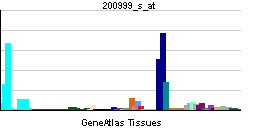CKAP4
| Cytoskeleton-associated protein 4 | |||||||
|---|---|---|---|---|---|---|---|
| Identifiers | |||||||
| Symbols | CKAP4 ; p63; CLIMP-63; ERGIC-63; MGC99554 | ||||||
| External IDs | Template:MGI HomoloGene: 4970 | ||||||
| |||||||
| RNA expression pattern | |||||||
 | |||||||
 | |||||||
| More reference expression data | |||||||
| Orthologs | |||||||
| Template:GNF Ortholog box | |||||||
| Species | Human | Mouse | |||||
| Entrez | n/a | n/a | |||||
| Ensembl | n/a | n/a | |||||
| UniProt | n/a | n/a | |||||
| RefSeq (mRNA) | n/a | n/a | |||||
| RefSeq (protein) | n/a | n/a | |||||
| Location (UCSC) | n/a | n/a | |||||
| PubMed search | n/a | n/a | |||||
Cytoskeleton-associated protein 4, also known as CKAP4, is a human gene.[1]
References
Further reading
- Mundy DI (1996). "Protein palmitoylation in membrane trafficking". Biochem. Soc. Trans. 23 (3): 572–6. PMID 8566419.
- Mundy DI, Warren G (1992). "Mitosis and inhibition of intracellular transport stimulate palmitoylation of a 62-kD protein". J. Cell Biol. 116 (1): 135–46. PMID 1730740.
- Schweizer A, Rohrer J, Slot JW; et al. (1995). "Reassessment of the subcellular localization of p63". J. Cell. Sci. 108 ( Pt 6): 2477–85. PMID 7673362.
- Maruyama K, Sugano S (1994). "Oligo-capping: a simple method to replace the cap structure of eukaryotic mRNAs with oligoribonucleotides". Gene. 138 (1–2): 171–4. PMID 8125298.
- Schweizer A, Rohrer J, Jenö P; et al. (1993). "A reversibly palmitoylated resident protein (p63) of an ER-Golgi intermediate compartment is related to a circulatory shock resuscitation protein". J. Cell. Sci. 104 ( Pt 3): 685–94. PMID 8314870.
- Suzuki Y, Yoshitomo-Nakagawa K, Maruyama K; et al. (1997). "Construction and characterization of a full length-enriched and a 5'-end-enriched cDNA library". Gene. 200 (1–2): 149–56. PMID 9373149.
- Klopfenstein DR, Klumperman J, Lustig A; et al. (2001). "Subdomain-specific localization of CLIMP-63 (p63) in the endoplasmic reticulum is mediated by its luminal alpha-helical segment". J. Cell Biol. 153 (6): 1287–300. PMID 11402071.
- Strausberg RL, Feingold EA, Grouse LH; et al. (2003). "Generation and initial analysis of more than 15,000 full-length human and mouse cDNA sequences". Proc. Natl. Acad. Sci. U.S.A. 99 (26): 16899–903. doi:10.1073/pnas.242603899. PMID 12477932.
- Razzaq TM, Bass R, Vines DJ; et al. (2004). "Functional regulation of tissue plasminogen activator on the surface of vascular smooth muscle cells by the type-II transmembrane protein p63 (CKAP4)". J. Biol. Chem. 278 (43): 42679–85. doi:10.1074/jbc.M305695200. PMID 12913003.
- Gerhard DS, Wagner L, Feingold EA; et al. (2004). "The status, quality, and expansion of the NIH full-length cDNA project: the Mammalian Gene Collection (MGC)". Genome Res. 14 (10B): 2121–7. doi:10.1101/gr.2596504. PMID 15489334.
- Vedrenne C, Klopfenstein DR, Hauri HP (2005). "Phosphorylation controls CLIMP-63-mediated anchoring of the endoplasmic reticulum to microtubules". Mol. Biol. Cell. 16 (4): 1928–37. doi:10.1091/mbc.E04-07-0554. PMID 15703217.
- Beretta C, Chiarelli A, Testoni B; et al. (2007). "Regulation of the cyclin-dependent kinase inhibitor p57Kip2 expression by p63". Cell Cycle. 4 (11): 1625–31. PMID 16258268.
- Ribeiro-Silva A, Becker de Moura H, Ribeiro do Vale F, Zucoloto S (2006). "The differential regulation of human telomerase reverse transcriptase and vascular endothelial growth factor may contribute to the clinically more aggressive behavior of p63-positive breast carcinomas". Int. J. Biol. Markers. 20 (4): 227–34. PMID 16398404.
- Gu X, Bäckman B, Coates PJ; et al. (2006). "Exclusion of p63 as a candidate gene for autosomal-dominant amelogenesis imperfecta". Acta Odontol. Scand. 64 (2): 111–4. doi:10.1080/00016350500443206. PMID 16546853.
- Conrads TP, Tocci GM, Hood BL; et al. (2007). "CKAP4/p63 is a receptor for the frizzled-8 protein-related antiproliferative factor from interstitial cystitis patients". J. Biol. Chem. 281 (49): 37836–43. doi:10.1074/jbc.M604581200. PMID 17030514.
- Troxell ML, Masek M, Sibley RK (2007). "Immunohistochemical staining of papillary breast lesions". Appl. Immunohistochem. Mol. Morphol. 15 (2): 145–53. doi:10.1097/01.pai.0000210420.45869.f4. PMID 17525625.
| This protein-related article is a stub. You can help Wikipedia by expanding it. |